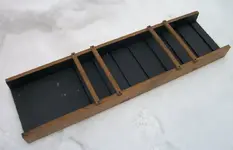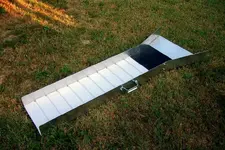Astrobouncer
Hero Member
- #21
Thread Owner
I made all the basic rough cuts with the saw, and yes I used a wood chisel to smooth them and make some changes. Also used sandpaper to help smooth the riffles. A smooth riffle is better because it allows the vortex action to occur. Too rough of a bottom and the riffle just fills up with material that cannot as easily be spiraled away. This slowing down of the vortex action can also happen if you overload the riffle by feeding it too fast.
It is, and there' something else that affects that which I will attempt to explain.
The velocity of the water in one of these sluices is greater because of the lack of obstructions like those that are in a normal sluice. Thus even if you have 1 inch rocks rolling down the board, the velocity pushing behind them will roll them over a 1 inch wide riffle. And if you have enough velocity they will likewise roll over even a 2 inch opening. Now you might think that's bad, but the heavier sands will definitely settle in the riffle, unlike a lighter stone. When I was out running this sluice last time, I had a nice size flake just slowly creeping its way down the slick plate until it got to the first riffle and buried itself in there. Whereas the lighter stuff just rolled on by and right out of the sluice. I also have been running one of my newer drop riffles emptying into one of my pans on the back, and no specs of gold in there yet.
I have noticed on my unclassified runs that even rocks 1/2 the size of the riffle will just roll on by and not drop in if they are only light gravel. The major problem with out classifying at all is some of the much larger 3+ inch rocks can cause a 'blowout' of material as the roll over a smaller riffle. But this problem can be somewhat mitigated by having some extra deep 1/8 inch groove at a 45 degree angle and below the main one. You can see where I did this on some of the sluices on my latest's one. A deeper simple straight one will work somewhat, but not as well as an angled version. Also if the rock is big enough and heavy enough, it can get hung up in the later part of the sluice with deeper riffles, thus blowing out all the smaller stuff there. Though it is doubtful any gold will have made it back that far, but you might lose garnets and other heavies.
I hate classifying too, and it really slows down an operation. I have some ideas I need to test that I think will allow one to just shovel material in without worry of classifying at all. Also, there is a great video about how to make a trap sluice, where you dont have to classify by Mike. I intend to make one of these to try out soon.
It is, and there' something else that affects that which I will attempt to explain.
The velocity of the water in one of these sluices is greater because of the lack of obstructions like those that are in a normal sluice. Thus even if you have 1 inch rocks rolling down the board, the velocity pushing behind them will roll them over a 1 inch wide riffle. And if you have enough velocity they will likewise roll over even a 2 inch opening. Now you might think that's bad, but the heavier sands will definitely settle in the riffle, unlike a lighter stone. When I was out running this sluice last time, I had a nice size flake just slowly creeping its way down the slick plate until it got to the first riffle and buried itself in there. Whereas the lighter stuff just rolled on by and right out of the sluice. I also have been running one of my newer drop riffles emptying into one of my pans on the back, and no specs of gold in there yet.
I have noticed on my unclassified runs that even rocks 1/2 the size of the riffle will just roll on by and not drop in if they are only light gravel. The major problem with out classifying at all is some of the much larger 3+ inch rocks can cause a 'blowout' of material as the roll over a smaller riffle. But this problem can be somewhat mitigated by having some extra deep 1/8 inch groove at a 45 degree angle and below the main one. You can see where I did this on some of the sluices on my latest's one. A deeper simple straight one will work somewhat, but not as well as an angled version. Also if the rock is big enough and heavy enough, it can get hung up in the later part of the sluice with deeper riffles, thus blowing out all the smaller stuff there. Though it is doubtful any gold will have made it back that far, but you might lose garnets and other heavies.
I hate classifying too, and it really slows down an operation. I have some ideas I need to test that I think will allow one to just shovel material in without worry of classifying at all. Also, there is a great video about how to make a trap sluice, where you dont have to classify by Mike. I intend to make one of these to try out soon.










